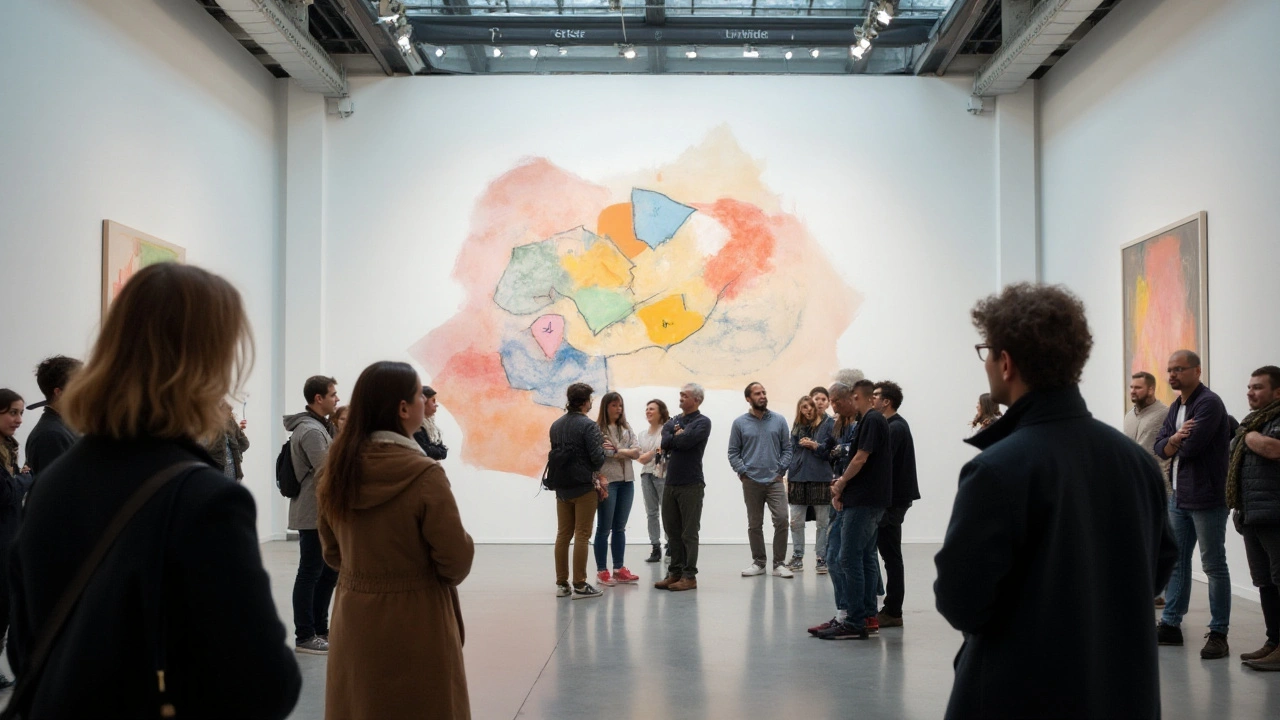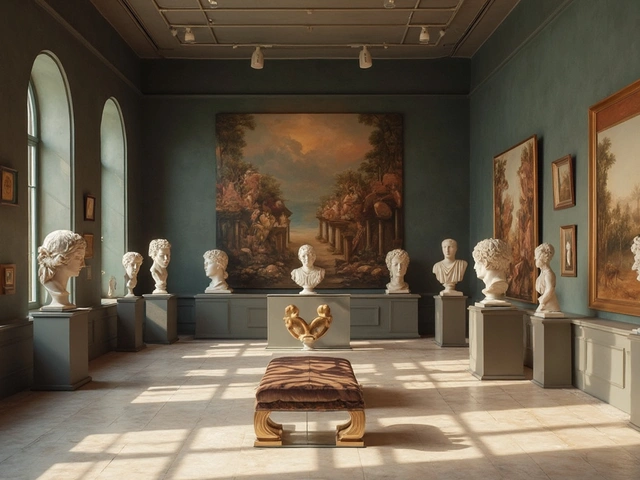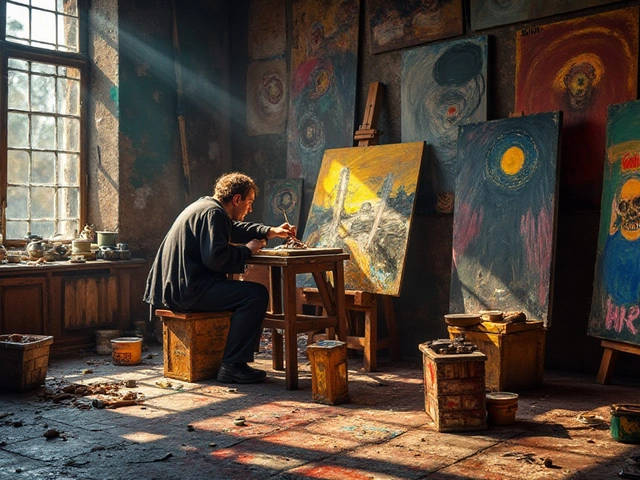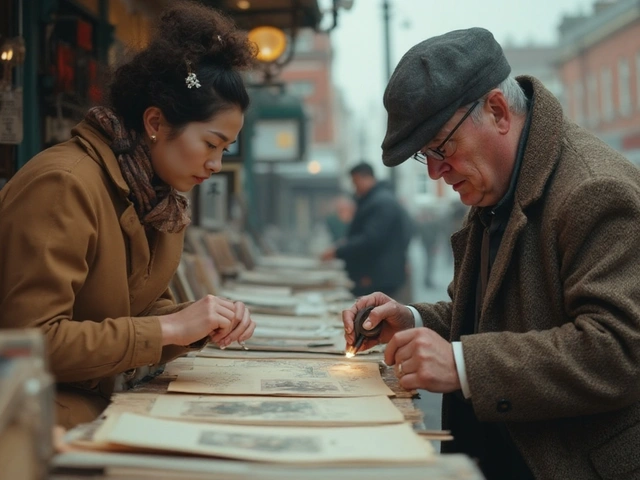Conceptual art is an artistic movement where the ideas behind the work take precedence over the traditional aesthetic and material aspects. Emerging in the 1960s, this form of art provokes thought and often challenges conventional perceptions of what art should be. At its core, conceptual art is less about visual experience and more about intellectual engagement. It asks the viewer to actively participate, to decipher, and to interpret, fostering a dialogue between the artist and the audience.
Driven by a desire to break away from classic artistic conventions, conceptual artists have often used unconventional mediums and methods. They commonly utilize everyday objects, words, and even actions as part of their work. This art form not only questions the definition of art itself but also what it represents and how it conveys meaning. Understanding conceptual art thus requires a willingness to engage with abstract concepts and hidden messages.
- Origins and Evolution
- Key Influencers and Movements
- Understanding Conceptual Art
- The Impact on Society
- Blurring Artistic Boundaries
- Tips for Appreciating Conceptual Art
Origins and Evolution
The history of conceptual art traces its origins to the revolutionary cultural shifts of the 1960s. During this time, artists began to shift their focus from traditional mediums such as painting and sculpture to ideas and concepts that challenged conventional art. The aim was to provoke thought rather than simply provide visual pleasure. This movement largely emerged as a response to the Abstract Expressionism and Minimalism of the previous decades, which, while pioneering in their own rights, were seen by some artists as too focused on formalism and material concerns. Conceptual art sought to break these chains of tradition, suggesting that the essence of art lies in the idea itself, rather than its physical form.
Joseph Kosuth and Sol LeWitt were among the pioneers who gave voice to what conceptual art could mean for the future of creativity. In his seminal 1969 essay "Paragraphs on Conceptual Art," LeWitt argued that "the idea becomes the machine that makes the art", emphasizing the precedence of the thought process over the finished product. These foundations allowed a new path for art where materials used became secondary to the message. This era saw an explosive growth in installations, performances, and textual art pieces that discarded traditional boundaries and considerations.
The shift was not limited to the physical boundaries of art but crossed continents, gaining momentum in Europe with influential figures like Marcel Duchamp, who predated but inspired the movement with 'readymades', and later Yoko Ono, whose experimental approaches pushed the boundaries of creativity and artistic expression. Their works challenged audiences to reconsider the cultural importance placed on art objects and invited more inclusive interpretations. As conceptual art matured into the 1970s and 80s, it integrated increasingly complex ideas, influenced by increasing philosophical discourse and social critique, which amplified its provocative nature.
A notable characteristic of conceptual art is its ability to create a platform for social commentary. Artists like Jenny Holzer used text installations to convey powerful statements illuminated in public spaces, prompting viewers to confront the realities of society. By the turn of the century, conceptual art had blossomed into a diverse array of forms, each reflecting underlying currents of contemporary thought, identity politics, and digital culture. This form of art continues to influence and unsettle, as today’s digital realm offers yet another landscape for conceptual exploration.
While initially controversial, conceptual art over time garnered critical acclaim and popularity, with pieces finding their way into prestigious collections and academic discourse. It demonstrates that art is capable of evolving continually, merging disciplines, and inviting not only admiration but critical thought. As historian Bernard Smith once stated, "Conceptual art is not about forms or materials but about ideas and meanings." It's this provocative potential and focus on intellectual engagement that have cemented its place as a seminal movement in the annals of modern art history.
Key Influencers and Movements
In the vibrant world of conceptual art, numerous visionaries have driven its evolution, leaving a lasting imprint on the art world. One such individual is Marcel Duchamp, whose provocative work 'Fountain,' a simple urinal signed "R. Mutt," challenged traditional definitions of art and inspired other artists to think outside the norm. His approach laid the foundation for crucial discussions about the nature of art and its boundaries, enabling artists to delve into concepts rather than rely on aesthetics alone. Duchamp was undeniably ahead of his time, shifting the focus away from what was visible to what was intellectual.
Another influential movement that championed the rise of conceptual art was Fluxus, thriving during the 1960s and 70s, with artists such as Yoko Ono, Nam June Paik, and George Maciunas at its forefront. This group's emphasis on the interdisciplinary nature of art encouraged blending various genres, often including performances, music, and literature. Fluxus artists saw everything as interconnected, believing that art should reflect the essence of everyday life and encourage participatory experiences. Their influence stretched far beyond their time, infusing the world with an understanding that art could encompass much more than a static canvas.
The ideas of Joseph Kosuth, particularly his essay "Art After Philosophy," became instrumental in articulating the philosophy underpinning conceptual art. He pursued the notion that the significance of art was rooted not in the aesthetic object but in the ideas it conveyed. Kosuth's work, frequently involving text and language, revealed the deeper connections between thought and visual representation. His famous 'One and Three Chairs' beautifully exemplifies his theory, juxtaposing a physical chair, a photograph of the chair, and a dictionary definition of "chair." This example illustrates how conceptual art compels viewers to engage in philosophical thought, another testament to Kosuth's pivotal role in the movement.
In the contemporary era, Ai Weiwei stands as a significant figure merging activism and art, consistently drawing attention to social and political issues. His conceptual works often use ordinary objects, imbued with profound messages, to challenge—and provoke—people's consciousness about injustice and human rights. By combining digital technology with traditional craftsmanship, Ai Weiwei's oeuvre exemplifies the dynamic and evolving nature of conceptual art. His work is a powerful reminder of the potential art holds to effect change and inspire dialogue among broad audiences.
"Art is not a thing – it is a way." - Elbert Hubbard. This quote succinctly captures the essence behind the conceptual art movement, emphasizing its transformative power—an artful interplay of thinking and doing that continuously questions and redefines the boundaries of human creativity.

Understanding Conceptual Art
To truly appreciate conceptual art, one must first comprehend its foundation: the idea that the significance of the artwork is rooted in its concept rather than its form. Originating in the 1960s, conceptual art emerged as a reaction against the elitism perceived in traditional art forms. Artists challenged the notion that art must be a tangible object with aesthetic beauty. Instead, they proposed art should provoke intellectual involvement, possibly even discomfort, as it questioned societal norms and assumptions.
The movement gained momentum through the works of pioneers like Sol LeWitt, whose 1967 manifesto emphasized that "the idea becomes a machine that makes the art." LeWitt, alongside artists like Joseph Kosuth, played a crucial role in turning attention away from technical skill and towards the cerebral engagement that art can inspire. Conceptual art relies on the audience's capacity to think beyond the material. Kosuth, in his famous work "One and Three Chairs," showcases a physical chair, a photograph of a chair, and a dictionary definition of a chair, pushing viewers to ponder the essence of representation itself.
Understanding conceptual art also involves recognizing its wide-ranging methods. Artists such as Yoko Ono and Lawrence Weiner have utilized text, installations, performances, and even instructions as their medium. Yoko Ono's "Cut Piece," for example, invites viewers to cut away her clothing while she sits passively, confronting ideas of vulnerability and control. Her work asked participants to actively become a part of the art, blurring lines between artist and audience. This transformative engagement is an essential element of conceptual art, emphasizing dialogue and diverse interpretations as part of the experience.
Despite its often minimalist appearance, conceptual art holds a wealth of meaning that can invite personal interpretations. At times, it can even appear perplexing or inscrutable. John Cage’s 4’33” consists of performers sitting silently at their instruments, with the ambient sound of the environment becoming the "music." Such works challenge the audience to consider what we define as art and its role in our lives.
"Art is not what you see, but what you make others see," said Edgar Degas, and conceptual art embodies this ethos by seeking to broaden perspectives.
Statistics indicate that a growing percentage of contemporary art collectors are drawn to conceptual pieces, as indicated by Sotheby’s recent auction data. The appeal lies in the dynamic conversations and the intellectual exploration it demands. The artwork invites spectators to approach it with an open mind, and to delve into layers of thought that might not be immediately apparent. This shift from the visual to the cerebral can prove challenging, but it also means that understanding conceptual art is as much about introspection and dialogue as it is about analysis.
For those keen on exploring this fascinating genre, a few tips can enhance the experience. Start by allowing yourself to sit with the discomfort of not immediately "getting it." Take time to understand the context of the piece and the artist's intended message—background research can provide invaluable insights. Engage with fellow viewers and experts, as discussion often uncovers multiple angles and shades of meaning. And remember, the beauty of conceptual art lies in its potential to foster unique interpretations, where each viewer's experience can differ vastly.
The Impact on Society
Conceptual art exerts significant influence on society by challenging the status quo and pushing the boundaries of what art can be. By prioritizing conceptual art over traditional aesthetics, it questions the societal norms surrounding the value and meaning of art. This art form often acts as a catalyst for social change, fostering conversations around pivotal issues such as politics, identity, and the environment. It empowers artists to use their platforms to voice perspectives that might otherwise be marginalized or ignored, enabling them to influence public discourse. The interaction between conceptual art and its audience is dynamic, as the meaning of the work unfolds through engagement, allowing different interpretations based on personal experiences and cultural contexts.
Many artists use conceptual art to highlight pressing social issues. For example, Yoko Ono's 'Cut Piece' is a powerful exploration of themes related to feminism, consumerism, and societal violence. Her performance-based work compels audiences to reflect on their roles within these structures, catalyzing discussions about change and responsibility. Similarly, the provocative nature of these works often unravels hidden truths about cultural and social systems. These elements make conceptual art an influential medium for promoting awareness and empathy. By exposing underlying biases and encouraging viewers to see the world from various perspectives, it can reshape public understanding and contribute to the development of a more inclusive society. As time progresses, its enduring appeal lies in its ability to resonate with current events, holding a mirror to society and challenging individuals to question their beliefs.
The influence of conceptual art on society also extends to its educational value. In schools and universities, conceptual art provides an opportunity to explore creativity and critical thinking. Students learn to appreciate art beyond visual aesthetics, engaging with deeper meanings and contexts. This fosters an educational environment where art is intertwined with current affairs and historical events, presenting it as a vital aspect of human communication. These educational experiences encourage students to think independently and approach problems from diverse perspectives. They learn that art is not only a reflection of society but also a tool for shaping it, which in turn inspires the next generation of artists and thinkers to continue pushing boundaries. By learning about influential conceptual works from artists like Joseph Kosuth and Sol LeWitt, students gain insights into the complex relationships between art, society, and individual expression.
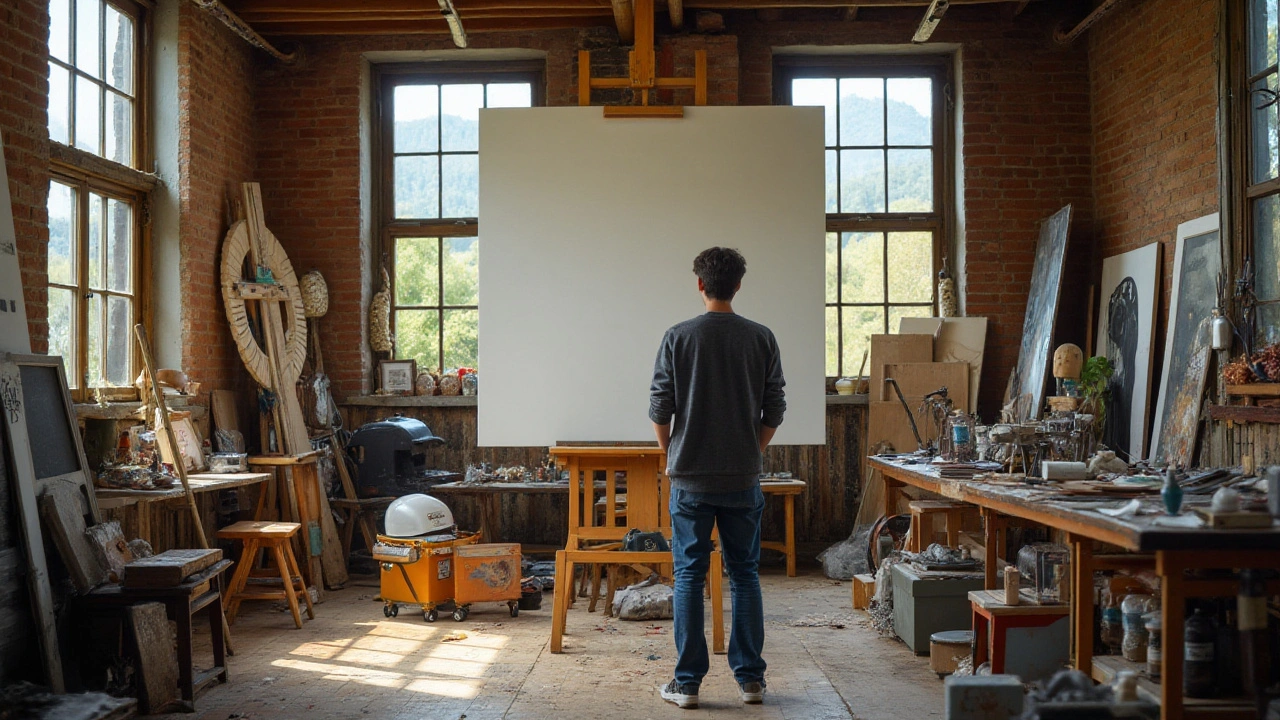
Blurring Artistic Boundaries
In the intriguing realm of conceptual art, the traditional lines that separate different artistic disciplines are often blurred to create a unique tapestry of innovation and expression. This movement shatters conventional barriers, allowing artists to transcend the usual confines of painting, sculpture, and other visual forms. One might encounter a piece that integrates literature, performance, and visual elements all in one, thereby defying established categories. This blending not only challenges the artists but also engages viewers in an unprecedented manner, asking them to reevaluate their understanding of art. Such fusion can be seen in works like Joseph Kosuth's 1965 installation 'One and Three Chairs', which combines a real chair, a photograph of the chair, and a dictionary definition of a chair. It encourages reflection on how context shifts perception.
This transformation speaks to the very heart of provocative art, questioning not only what art can be but also how it can be experienced. By erasing boundaries, conceptual artists invite a new form of participation from their audience. As John Cage famously noted, "Art’s purpose is to sober and quiet the mind so that it is in accord with what happens." These mixed-media works, performances, and installations often eschew narrative coherence in favor of a more disrupted, interactive approach. They raise essential questions about the link between artist intention and viewer interpretation, thereby forging a new dynamic in artistic discourse. This active engagement delineates conceptual art's success in bridging gaps across disciplines and communities.
In this journey of boundary dissolution, collaborations between artists from different fields are not uncommon. Such partnerships highlight the multidimensional nature of creative process and open up a wealth of possibilities. For instance, Marina Abramović’s collaborations with international architects and engineers for her performance pieces carry the spirit of boundary-blurring. By working together, these artists expand their toolkits and reach audiences in innovative ways, illustrating how art, at its core, is a communal experience, continually evolving. Through these synergies, they push the limits of traditional practices, ensuring that conceptual art remains a dynamic, evolving form.
| Artist | Work | Year |
|---|---|---|
| Marcel Duchamp | Fountain | 1917 |
| Jenny Holzer | Truisms | 1978-87 |
| Yoko Ono | Grapefruit | 1964 |
Ultimately, this fusion of traditionally distinct domains has profound implications for the reception and sustainability of art itself. As new generations of artists build on this legacy of boundary-blurring, they set the stage for even more integrated and pluralistic artistic expressions. Concepts once relegated to the periphery now take center stage, urging societies to embrace diversity, adaptability, and the intersections of ideas and forms. The fluid merging of genres and disciplines makes conceptual art not only a movement but a deeply transformative encounter that reflects and shapes our modern world. By embracing these mutations, art becomes a limitless form of expression, capable of resonating across different layers of culture and identity. Thus, it heralds a future where art is an active participant in life’s complex, interwoven narrative.
Tips for Appreciating Conceptual Art
Appreciating conceptual art can seem like a daunting task at first. This art form often lacks the visual beauty found in traditional paintings and sculptures, instead emphasizing the concept itself as the primary focus. To truly enjoy this category, it's essential to shift your mindset from expecting visual appeal to seeking intellectual stimulation. Begin by considering the artist's intention. What are they trying to say through this piece? Artists often embed social, political, or personal messages within their works, using unconventional materials or techniques to grab your attention. Prioritize understanding the message over aesthetic appeal, and you'll discover a new depth in the art.
One effective approach is to engage with the artwork actively. Spend time in front of the piece and allow yourself to reflect on it. Asking questions can be beneficial—why was this material chosen? What cultural references are embedded in the work? Sometimes reading about the context or story behind the piece can unlock layers of meaning you might have missed. Opening up to different interpretations is crucial as the same piece can present multiple perspectives. It's also important to consider the historical and cultural backdrop of the time when the piece was created, as it often influences the artist’s message and material choice significantly.
It can be helpful to focus on the artist's process. Understanding the steps undertaken by the artist to arrive at their final product can be revealing. Look for behind-the-scenes stories involving trials, errors, and breakthroughs. This insight can offer a richer appreciation of the work. Engage with other viewers to hear different interpretations and ideas. Such discussions can illuminate concepts you may not have considered and enrich your experience. As the celebrated artist Sol LeWitt once said, "The idea becomes a machine that makes the art."
Famed conceptual artist Sol LeWitt once noted, "The idea becomes a machine that makes the art." This perspective underlines the critical element of process in conceptual art.
Don’t rush your experience; instead, let patience guide you. Allow yourself time to consider the context and meaning, and resist the urge to dismiss what you do not instantly understand. Over time, and with repeated exposure, conceptual art often reveals more layers and delightful subtleties. By fostering curiosity, you allow yourself the space to develop a more profound appreciation. To embrace this art form fully, remember that there isn't always one correct interpretation—part of its magic lies in its ability to mean different things to different people. The impact of conceptual art often extends beyond the immediate encounter, leaving impressions that resurface long after the gallery visit has ended.

